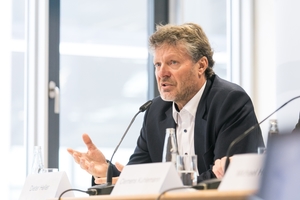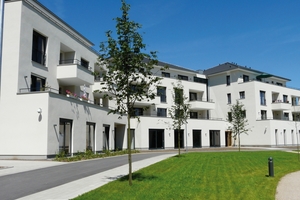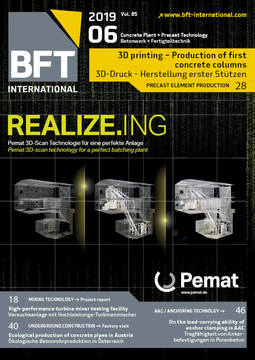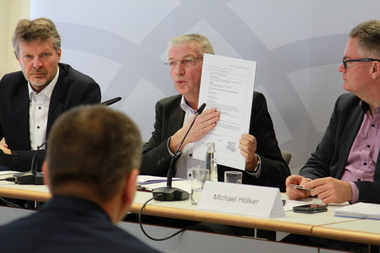Uniform solution for construction products
The ECJ has ruled that requirements of national building regulations may no longer be imposed on European harmonized construction products. For that reason, the German lightweight concrete industry offers for its products Declarations of Performance under private law, which are intended to supplement the CE markings. “The concept of requirements documentation by a manufacturer’s declaration ensures that all descriptions, declarations of conformity and attestations required by building regulations are available to clients and the construction authorities – from planning and design to implementation,” explains Dieter Heller, the General Managing Director of the Federal Association of the German Lightweight Concrete Industry (in Neuwied, Germany).
With this possibility, the German lightweight concrete industry follows a joint declaration of the German Federal Chambers of Architects and Engineers and several German construction materials associations, which have jointly worked out the new concept. “Following abolition of the Ü conformity mark, the high safety standards in the construction industry must continue to be upheld,” emphasizes Heller.
German lightweight-concrete industry supplements CE conformity marking
In the European Union, standards and codes of practice are gradually being rendered uniform to prevent isolation of national markets on a European level. This harmonization, as it is referred to, also applies to the construction industry. At the same time, however, it must be ensured that the requirement standards within a country are not lowered by harmonization: a factor which, in Germany, was until now taken account of by the Ü-mark. This label was applied to CE-marked products that satisfied not only European criteria but in addition, German national requirements as well. The European Court of Justice (ECJ) has now put a stop to this practice of double labelling.
In order to accelerate the harmonization process for manufacturers in the EU, national requirements are now planned to be replaced by European-wide requirements. The judgment of the ECJ (C-100/13) dated 16 October 2014 states: In future, state authorities may no longer require Europe-harmonized CE-marked construction products to be supplemented with additional national requirements. In this way, uniform evaluation of construction products will be ensured throughout Europe. Accordingly, quality marks such as the Ü-mark used in Germany may no longer be used on harmonized construction products. This confronted not only architects and specialist planners, but the entire German construction sector, with the challenge of finding an alternative presentation of quality assurance.
The issue
The change to the German state building regulations and the publication of the new Model Administrative Regulation for Technical Building Rules (MVV-TB) in August 2017 provides that requirements of the German building regulations may no longer be imposed on construction products with European harmonization. This bars the doubling of CE and Ü conformity marking – as ruled by the ECJ. At the same time, the characteristics required of the building regulations will, in future, be linked to the structure itself. Accordingly, the characteristics required must no longer be attested to for the product, but for the entire structure.
The solution
In order to ensure that requirements placed on structures by the German building regulations are also met in the future, several manufacturing associations as well as the German Federal Chambers of Architects and Engineers have joined forces. Together, they have developed Requirement Documents under private law. In future, these must specify the performance characteristics of the individual construction products. Conformity with the requirements of a structure must be attested to by manufacturers’ declarations or expert opinions.
“The objective had been to transpose the requirements of German Building Regulations (Bauordnungsrecht) in a legally secure manner for use on Europe-harmonized construction products,” explained Dipl.-Ing. Dieter Heller of the Federal Association of the German Lightweight Concrete Industry. “Moreover, for us as industry it is important to offer a pragmatic solution that quickly re-establishes certainty.” In addition to the Federal Association of the German Lightweight Concrete Industry, 15 other associations of the German construction industry as well as the relevant professional Chambers, by their signatures, declared themselves responsible for the new system.
The details
Already in the invitation to tender and procurement, the newly created requirement documents specify the performance characteristics that a construction product must meet to satisfy the requirements of a structure. The respective document then serves as the basis for contract, order and delivery documents. Both third party monitoring of the products and factory production control will be continued in the familiar way. The system is now also anchored in the respective regulation. DIN 18200:2018, for example, contains a sample for a voluntary manufacturer’s declaration: “Verification of conformity for construction products – factory production control, third-party monitoring and certification.” The standard was published in August 2018 and now enables verification of conformity for additional characteristics in harmonized construction products.
The requirement documents were prepared in expert committees to ensure complete coverage of all product characteristics required for satisfying the requirements of a structure. Among the participating parties were public and private clients, planners, product manufacturers, building contractors and inspection engineers. Following harmonization of the documents with the building regulation control authority of the German states, they will be considered as voluntary technical documentation.





